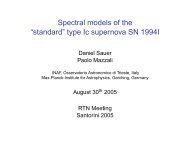Co-Investigator - The Gamma-Ray Astronomy Team - NASA
Co-Investigator - The Gamma-Ray Astronomy Team - NASA
Co-Investigator - The Gamma-Ray Astronomy Team - NASA
- No tags were found...
You also want an ePaper? Increase the reach of your titles
YUMPU automatically turns print PDFs into web optimized ePapers that Google loves.
2.6.2 Electrical<strong>The</strong> electrical interface presents no complications.<strong>The</strong> Burst Monitor requires unregulated power,clock, command, and telemetry lines. <strong>Co</strong>mmunicationwith the LAT, if desired, can be achievedthrough the spacecraft using data in the telemetrypacket, or by a direct interface to the LAT. <strong>The</strong>power requirements are summarized in table 10.<strong>The</strong> total power is 17.8 watts, without contingency.<strong>The</strong> required telemetry rate is normally 4 kbps,increasing to 9 kbs during bursts, as was describedin more detail in section 2.2.2.6.3 <strong>The</strong>rmal<strong>The</strong> spacecraft will provide thermal control andinsulation. <strong>The</strong> MSFC Engineering Directorate willuse thermal radiation analyzer system (TRASYS)and system improved differencing analyzer(SINDA) computer models to support the GRBMthermal and thermal/vacuum testing. Preliminaryanalysis shows the following thermal requirements.Detectors0 to 20 °C operational, –10 to 30 °C storage, stable1 °C over one orbit. <strong>The</strong> stability requirement isderived from the need for short term gain stability.<strong>The</strong> AGC can maintain stability over longer times.Electronic Boxes0 to 50 °C operational, –30 to 90 °C storage.2.7 Ground System and Operations2.7.1 Requirements and Operations <strong>Co</strong>ncept<strong>The</strong> ground system for the GBM is a hardware andsoftware system that accepts instrument data fromthe GLAST MOC and produces scientific data sets.<strong>The</strong> system also monitors instrument performanceand safety.<strong>The</strong> GBM IOC receives data from the instrumentvia the MOC, and converts it into standard low-leveldata products for distribution to the GLAST SOC.<strong>The</strong> system data flow for GBM is shown infigure 30.Figure 30.—System Data Flow for the GLAST Burst Monitor.42



